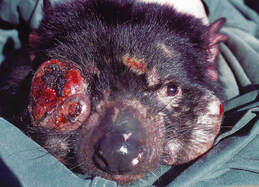The Devils that Make Us Care
 Cute little fella, isn't he? In unfettered, expressive prose, Author Dorothy Hinshaw Patent explains how he got the name:
Cute little fella, isn't he? In unfettered, expressive prose, Author Dorothy Hinshaw Patent explains how he got the name:"The devil got its name in the early 1800s, when the first English settlers arrived. Imagine being one of those settlers. Darkness falls over your campsite and you are trying to sleep, when suddenly you hear mysterious, frightening sounds--unearthly screams and shrieks echoing through the forest. The sounds alone frighten you, but then you see movement in the moonlight-- a black creature disappearing into the night. You believe in the existence of the devil...."
And so, the largest carnivore on the islands of Tasmania got a name it didn't deserve. In recent years, it has developed a horrible disfiguring disease that it also didn't deserve called Devil Facial Tumor Disease or DFTD. It was kind of a contagious cancer that almost destroyed some devil populations by as much as 95% in 2005, almost twenty years after it was first detected in 1996.
 This was not a case of the "devil got his due." This was an alarm bell to field scientists who understood that the Tasmanian devil was a keystone species. Its loss would cause an overrun of all the animals it fed on thus destroying the balance of nature in its environment. Dorothy Patent was in the fortunate position to have a concerned scientist friend in Australia who offered her the chance to tell the story about saving the Tasmanian devil.
This was not a case of the "devil got his due." This was an alarm bell to field scientists who understood that the Tasmanian devil was a keystone species. Its loss would cause an overrun of all the animals it fed on thus destroying the balance of nature in its environment. Dorothy Patent was in the fortunate position to have a concerned scientist friend in Australia who offered her the chance to tell the story about saving the Tasmanian devil. As the latest addition to the terrific Scientist in the Field series, Saving the Tasmanian Devil: How Science Is Helping the World's Largest Marsupial Carnivore Survive, Patent tells a riveting story of a race against time before a gruesome disease of a wild animal in a faraway land causes its extinction the face of this earth. Coincidentally, we're also learning from this study information that may contribute to our knowledge of cancer in humans.
One of the great values of this book is how Patent learned to know what she needed to know to tell this story. She and her husband went to Australia and Tasmania and met with the concerned scientists working on the problem. It turns out that DFTD is a unique genetic disease with some quirky properties scientists had never seen before. I loved her clear explanation of exactly how the genes from the diseased devils were scrambled into a pattern where pieces of chromosomes became attached to other chromosomes in weird ways.
Meanwhile the reader learns much about the devil and other marsupial mammals of this unique part of the world. The photographs capture the wild beauty of a place barely colonized by humans. Saving the Tasmanian Devil is an epic story from a foreign landscape that catches the heart and inspires the mind. May it find its way into the hands of curious readers from middle school up.
Published on September 16, 2019 11:09
No comments have been added yet.



